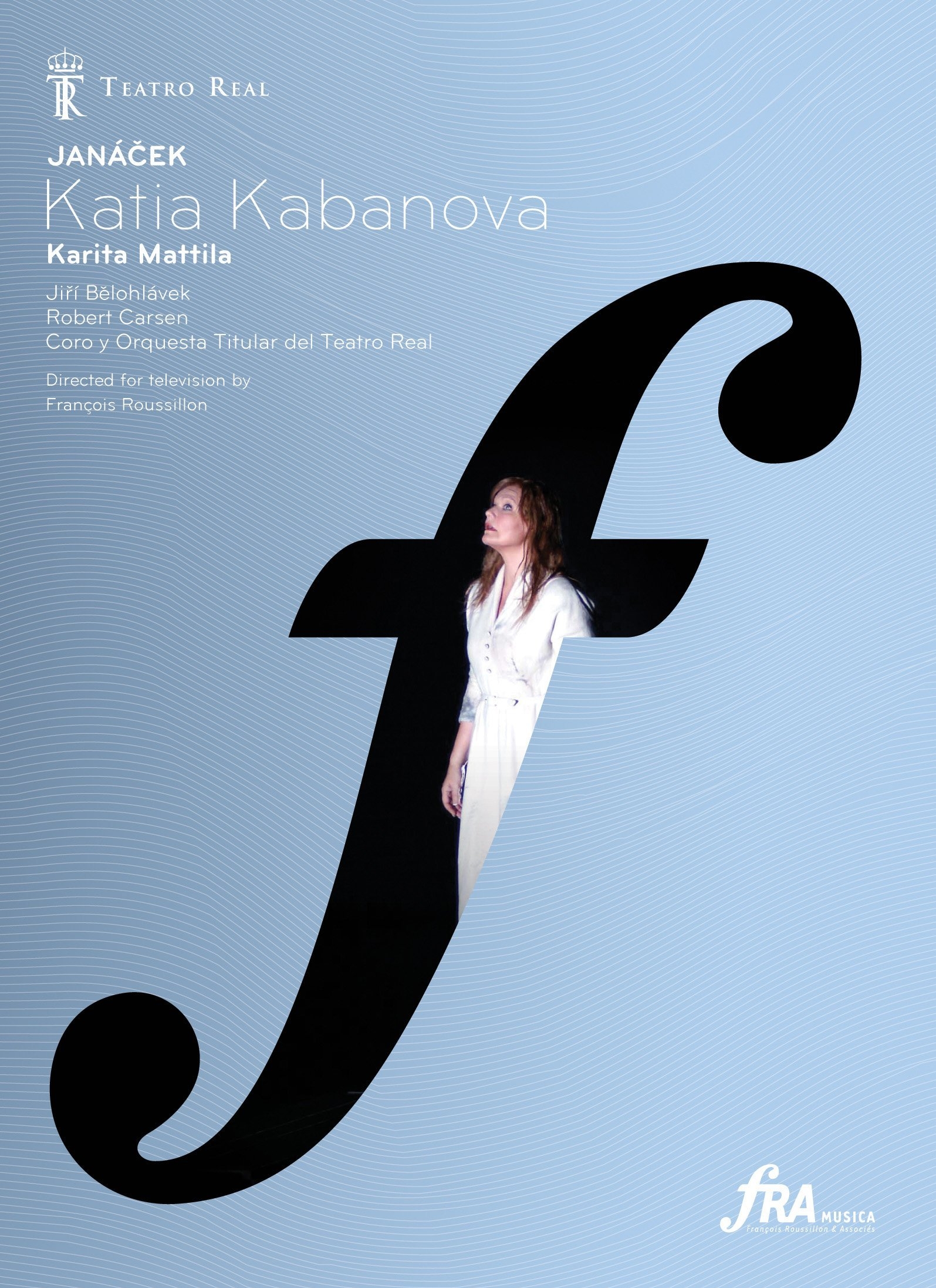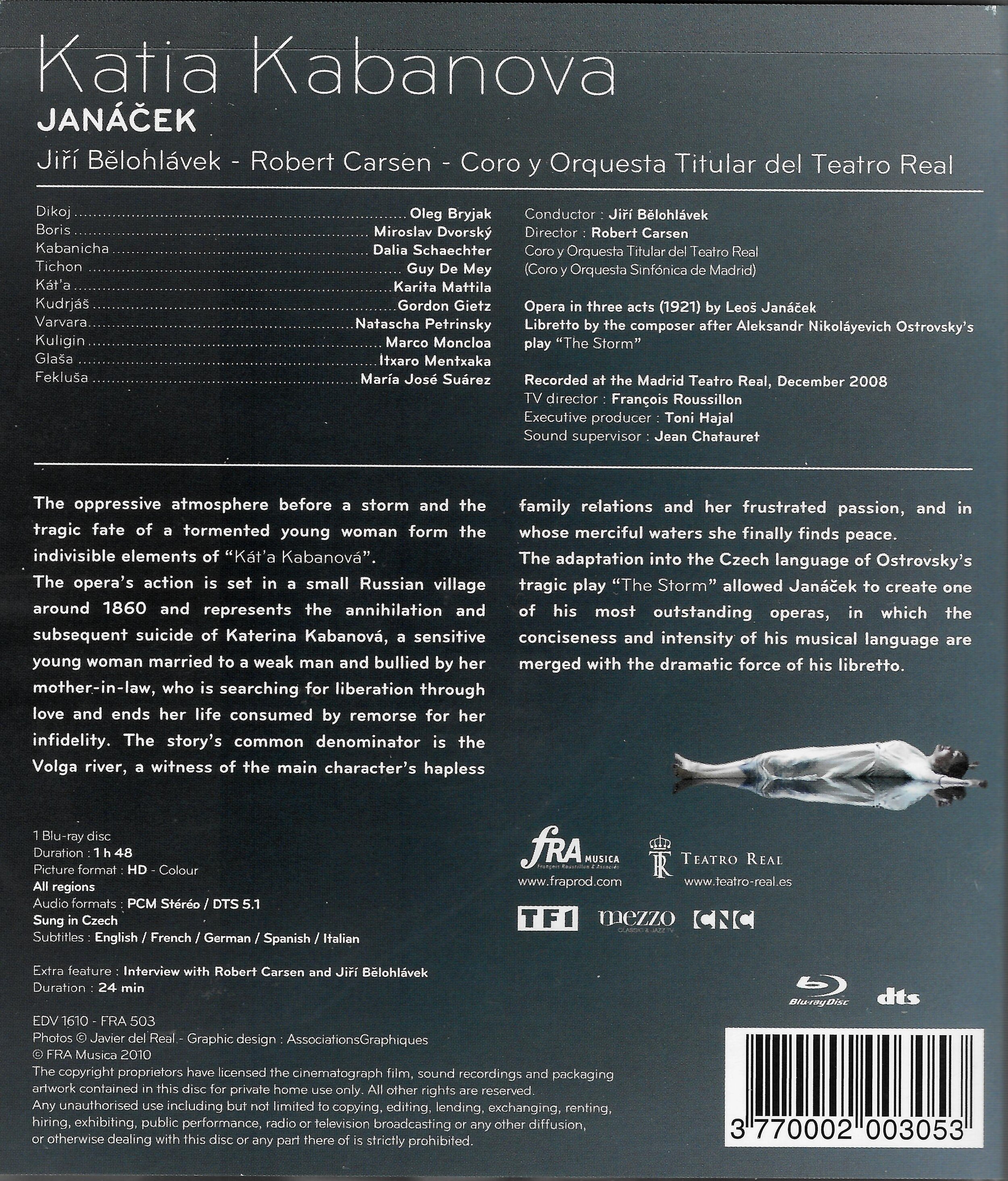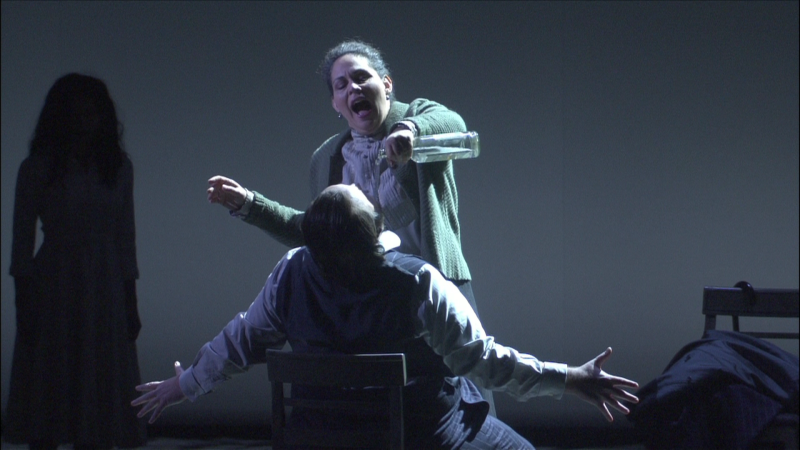

Leoš Janáček Katia Kabanova opera to libretto by the composer based on The Storm, a play by Alexander Nikolayevich Ostrovsky. Directed 2008 by Robert Carsen at the Teatro Real in Madrid. Stars (in order of appearance) Oleg Bryjak (Dikoj), Miroslav Dvorský (Boris), Dalia Schaechter (Kabanicha), Guy De Mey (Tichon), Karita Mattila (Kát'a), Gordon Gietz (Kudrjáš), Natascha Petrinksy (Varvara), Marco Moncloa (Kuligin), Itxaro Mentxaka (Glaša) and María José Suárez (Fekluša). Jiří Bělohlávek conducts the Orchestra and Chorus of the Teatro Real (Chorus Master Peter Burian). Dancers are Ana Aguilar, Magdalena Aizpúrua, Diana Bernedo, Vanesa Calderón, Sandra Cardozo, Leticia Castro, Lorena Díaz, Henar Fuentetaja, Rebeca González Lázaro, María González, Marta Gorriz, Salome Jimenez, Amaia Otcabide, Marta Marcelli, Carmen Mayordomo, Natalia Méndez, Carolina Pastor, Yara Paz, Vanesa Tejedor, Almudena Ramos, Licía Rey Castillo, Diana Samper, Isabel Sánchez, Ainhoa Sarmiento, Beatriz Silva, Izaskun Valmaseda, and Aisha Wizuete. Sets and costumes by Patrick Kinmonth; lighting by Robert Carsen and Peter van Praet; choreography by Philippe Giraudeau; sound supervision by Jean Chatauret. Directed for TV by François Roussillon; produced by Tony Hajal. Released 2010, disc has 5.1 dts-HD Master Audio sound. Grade: A-
Director Robert Carsen now has 6 opera credits in HDVD where he specializes in updating older works with clever new designs and overlays while avoiding the inexplicable excesses of Regietheater or Eurotrash. (See also our reviews for Carsen's Armide, Rinaldo, Tannhäuser, Die Zauberflöte, and Semele.) For this Katia Kabanova, Carsen chucks out forests, villages, and period furniture. Instead, he and Kinmonth cover the entire stage with about 1 inch of Volga river water and add a huge mirror behind to create more water images through reflection.
To create land mass for the protagonists in contemporary dress, (up to) 27 Kát'a ghosts (dressed in Kát'a's signuture white dress) splash about as stage hands putting duckboard platforms together to form the banks of the Volga, a fitting room at home, the garden, and other locations. When not moving boards, the ghosts have many opportunities to act as a silent chorus and to fall into the water, thrash about, and drown. Never before was the death of a character so often foreshadowed. In special honor of all those wet bottoms, here's a shot of the Kát'a ghosts at the curtain call:
Here's a shot (from the storm scene) of the ghosts in action:
Carsen's final striking design element is the use of low lighting throughout. This opera could have been called "The Storm." When the opera opens, the storm is already raging in Kát'a's heart. The build-up in the clouds is unrelenting before the outbreak of the storm over the Volga and Kát'a's devastating breakdown. The dark mise-en-scène is intended to contrast with the pervasive image of Kát'a (and her ghosts) in white.
Below are three of the main characters. On the left is Kabanicha (Dalia Schaechter), widow of a rich merchant. On the right is her weak and alcoholic son, Tichon (Guy De Mey), who is married to Kát'a. Kát'a (Karita Mattila) is in the center dressed in white. Extremely religious and pious, she is the most docile and meek wife and daughter-in-law that you could imagine. Here Kát'a receives an all too common and undeserved tongue lashing from Kabanicha, the most aggressive and overbearing mother and mother-in-law you could imagine:
Kabanicha has a foster daughter Varvara (Natascha Petrinksy). Varvara is young and a bit rebellious. She has no illusions about her obnoxious foster mother or her weakling foster brother. "I know what you are thinking about!" she says as she pours out Tichon's vodka. Carsen views Varvava as a reprehensible trouble-maker. But I think Varvara is the most normal character in the opera. Still, I agree with Carsen that Varvara could not comprehend how troubled Katia would be following her adultery.
Varvara is a seamstress:
Kát'a reveals that she feels passion for another man. She tells Varvara of her fantasies about him. To Kát'a, even thinking about another man is a great sin:
Tichon has to go on a business trip. Kabanicha insists that Tichon and Kát'a go through an obedience ritual. Tichon loves Kát'a and doesn't want to humiliate her in this way. But he is powerless to stand up to his mother. This pathetic scene only reinforces the revulsion Kát'a feels for her impotent husband and her desire find love with a real man:
Varvara has figured out that Boris Grigorievich is the man Kát'a loves. She gives Kát'a a key to the back gate so Kát'a can sneak out to meet Boris while Kabanicha is asleep:
In the meantime, Kabanicha lustily entertains Dikoj, a scurrilous businessman who is also the uncle of Boris Grigorievich. In this small village, everybody knows everybody; and the lives of the main characters are related in a kind of house of cards:
While Tichon is gone and Kabanicha sleeps, Varvara and her lover meet outside the gate and go for walks along the river:
Below is Varava's best line. In just a few days she will find out how dangerous her actions really are when the house of cards falls down:
Following Varvara's lead, Kát'a also has been going for walks along the river with Boris. Tichon has returned. Kát'a is caught between the joy she feels for her new love and her guilt over betraying her husband. As the storm breaks out around them, Kát'a confesses her infidelity in public to Tichon:
The storm continues:
Kabanicha locks up Varvara. But Varvara escapes, and she and her lover flee to Moscow to find a new life. Now Kát'a learns that Boris is scarcely a stronger man than Tichon. Dikoj, Kabanicha's pal, is trustee of Boris' inheritance. Dikoj owes money to Kabanicha (I think). To placate Kabanicha, Dikoj orders Boris to go alone into exile at a trading post in Siberia. Boris knuckles under and abandons Kát'a:
The collapse of the house of cards has left Kát'a alone. She can only find solace in the river:
Karita Mattila seems to have been the leading Kát'a interpreter in the world when this was made. She and the rest of the cast combine apt appearance with excellent singing and acting.
The grim Carsen designs must have been daunting for François Roussillon as he captured this on video. But in my HT, the dark images are quite acceptable. There is, however, a weakness with the sound recording: the singers sound distant, muffled, somewhat overshadowed by the orchestra. I didn't notice this at first, probably because I was relying on the English subtitles and paying no attention to the Czech dialog. But as I got to know the production better, I began to notice the hollowness of the voices.
Jiří Bělohlávek is one of the world's foremost authorities on Janáček orchestra scores. Although one critic said the orchestra in Madrid was having trouble with the score, both the playing and recording of the orchestra seems fine to me.
I've noted 3 magazine reviews with 3 different opinions of this production:
Nigel Simeone tackled subject title in the February 2011 International Record Review (page 69). Simeone, an opera and Janáček expert, is vastly better qualified than I to compare this production with legacy material. He found Carsen's vision too austere, chilly, and lacking in "claustrophobia." He concludes, "This is a bizarrely uninvolving production of an operatic masterpiece that deserves far better." I note that Simeone apparently saw this in DVD and was not aware that this was available in Blu-ray. I agree with Simeone to this extent: I would not want to watch this title in DVD. Would Simeone have liked it better if he had the opportunity to see it more clearly? To me Carsen's design of vast, open, dark spaces contrasting sharply with Kát'a's white dress results in strong psychological claustrophobia---at the end, Kát'a is trapped ard constricted by the entire universe.
David Shengold, writing in the May 2011 Opera News (page 79) takes a middle road. He's perturbed by all the water and the ghosts, but he can handle it. He makes this observation that I so wish I had thought of: "Carsen does wonders with intimate blocking and Personenregie; the scene of the heroine's farewell to Boris is devastatingly staged." This observation could be extrapolated, I assert, to everything that Carsen does. Shengold makes the following statement that got my attention: "American audiences are not the only ones being taught to hear opera singing with their eyes." Right on. Much of my life there was no opera to attend where I lived. I'm 10 times more interested in opera now that I have it on demand in my HT than I was when I had it on miserable LPs or A.M. radio on Saturday afternoon.
Finally, Gramophone made the Carsen Katia Kabanovait's "Editor's Choice" in the DVD and Blu-ray catagory for the April, 2011 magazine (page 95). Richard Lawrence called it, "Utterly brilliant!" And this was based on the DVD disc---the folks at Gramophone didn't know it was available in Blu-ray!
Let's sum up. If you can enjoy the modern design, this title has just about everything going for it except the somewhat hollow and distant recording of the voices, It's the best video available now of KK. When I first saw this, I was bowled over and gave it an A+. On re-review, I'm backing off this highest grade, because of the controversial design and the oddly recorded voices, to an A-.
Here's the only watchable clip from Katia Kabanova I could find. Creating the wet stage involved many problems including coping with public health regulations in each venue where the production was staged:
Alert! May now be a collectors item.


















